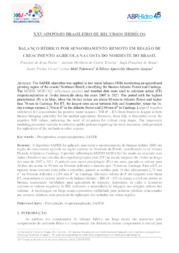Balanço hídrico por sensoriamento remoto em região de crescimento agrícola na costa do nordeste do Brasil.
Balanço hídrico por sensoriamento remoto em região de crescimento agrícola na costa do nordeste do Brasil.
Author(s): FARIAS, F. DE J.; TEIXEIRA, A. H. DE C.; SOUZA, I. F. DE; LEIVAS, J. F.; TAKEMURA, C. M.; GARCON, E. A. M.
Summary: RESUMO: O algoritmo SAFER foi aplicado para testar o monitoramento do balanço hídrico (BH) em região de crescimento agrícola na região costeira do Nordeste do Brasil, classificando-se os biomas Floresta Atlântica e Caatinga. O produto reflectância MODIS MOD13Q1 foi usado em conjunto com dados climáticos nos cálculos da evapotranspiração atual (ET) na escala temporal de 16 dias ao longo dos anos de 2007 a 2021. O período com maior precipitação (P) é em maio, quando os valores para 16 dias são acima de 90 mm na Floresta Atlântica e maiores que 70 mm na Caatinga. Para a ET, as maiores taxas ocorrem entre julho e setembro, quando as médias para 16 dias ultrapassam 2,70 mm d-1 na Floresta Atlântica e 2,90 mm d-1 na Caatinga. Elevados valores de P em conjunto com baixa ET, concentram os valores positivos de balanço hídrico – BH (P – ET) de março a abril em ambos os biomas, acarretando viabilidade para agricultura de sequeiro. Entretanto, de julho a dezembro ocorrem os valores negativos de BH, indicando a necessidade de irrigação nos estágios críticos das culturas. A modelagem em larga escala apresentou viabilidade para políticas públicas relacionadas aos recursos hídricos, com potencial de replicação dos métodos em outras regiões. ABSTRACT: The SAFER algorithm was applied to test water balance (WB) monitoring an agricultural growing region of the coastal Northeast Brazil, classifying the biomes Atlantic Forest and Caatinga. The MODIS MOD13Q1 reflectance product and weather data were used to calculate actual (ET) evapotranspiration at 16-day timescale along the years 2007 to 2021. The period with the highest precipitation (P) is in May, when the 16-day values are above 90 mm in Atlantic Forest and higher than 70 mm in Caatinga. For ET, the largest rates occur between July and September, when the 16- day average surpass 2.70 mm d-1 in the Atlantic Forest and 2.90 mm d-1 in Caatinga. Larger P together with lower ET concentrates the positive water balance - WB (P – ET) from March to August in both biomes bringing suitability for the rainfed agriculture. However, from July to December occur the negative WB values, indicating the need of irrigation for critical crop stages. The large-scale modeling presented viability to subsidize public policies regarding the water resources, with potential for replication of the methods in other regions.
Publication year: 2023
Types of publication: Paper in annals and proceedings
Unit: Embrapa Territorial
Observation
Some of Embrapa's publications are published as ePub files. To read them, use or download one of the following free software options to your computer or mobile device. Android: Google Play Books; IOS: iBooks; Windows and Linux: Calibre.
Access other publications
Access the Agricultural Research Database (BDPA) to consult Embrapa's full library collection and records.
Visit Embrapa Bookstore to purchase books and other publications sold by Embrapa.

